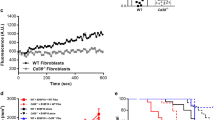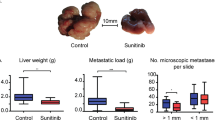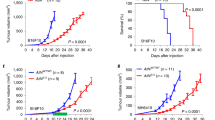Abstract
Vascular endothelial growth factor (VEGF) production by stromal fibroblasts plays an important role in tumor angiogenesis. However, VEGF is also expressed by normal tissue fibroblasts, raising the question of how the VEGF activity of fibroblasts is regulated. Here we report that the latent VEGF angiogenic activity of fibroblasts is activated by cancer cells, resulting in tumor-selective utilization of fibroblast-derived VEGF. Through the production of VEGF, human VA-13 fibroblasts promote angiogenesis in and growth of human pancreas cancer Capan-1 xenograft tumors, whereas VA-13 fibroblasts alone do not show significant angiogenesis. Treatment of VA-13 fibroblast supernatant with matrix metalloproteinase-7 (MMP-7), an extracellular proteinase characteristically expressed by cancer cells, elicits endothelial tube formation. This effect is abrogated by anti-VEGF antibody or connective tissue growth factor (CTGF), which was previously reported to sequester VEGF and be degraded by MMP-7. Suppression of MMP-7 in Capan-1 cells abrogates the tumor angiogenic activity of VA-13 fibroblasts, which is restored by suppression of CTGF in VA-13 fibroblasts. We further show that these molecular mechanisms that trigger angiogenesis are effective in human primary fibroblasts and human colorectal tissue. These data suggest that fibroblasts may store VEGF in a latent state in the extracellular environment for urgent use in angiogenesis.
This is a preview of subscription content, access via your institution
Access options
Subscribe to this journal
Receive 50 print issues and online access
$259.00 per year
only $5.18 per issue
Buy this article
- Purchase on Springer Link
- Instant access to full article PDF
Prices may be subject to local taxes which are calculated during checkout





Similar content being viewed by others
References
Ambati BK, Nozaki M, Singh N, Takeda A, Jani PD, Suthar T et al. (2006). Corneal avascularity is due to soluble VEGF receptor-1. Nature 443: 993–997.
Bergers G, Brekken R, McMahon G, Vu TH, Itoh T, Tamaki K et al. (2000). Matrix metalloproteinase-9 triggers the angiogenic switch during carcinogenesis. Nat Cell Biol 2: 737–744.
Berse B, Brown LF, Van de Water L, Dvorak HF, Senger DR . (1992). Vascular permeability factor (vascular endothelial growth factor) gene is expressed differentially in normal tissues, macrophages, and tumors. Mol Biol Cell 3: 211–220.
Brigstock DR, Steffen CL, Kim GY, Vegunta RK, Diehl JR, Harding PA . (1997). Purification and characterization of novel heparin-binding growth factors in uterine secretory fluids. Identification as heparin-regulated Mr 10 000 forms of connective tissue growth factor. J Biol Chem 272: 20275–20282.
Brigstock DR . (1999). The connective tissue growth factor/cysteine-rich 61/nephroblastoma overexpressed (CCN) family. Endocr Rev 20: 189–206.
Carmeliet P, Jain RK . (2000). Angiogenesis in cancer and other diseases. Nature 407: 249–257.
Chen Y, Abraham DJ, Shi-Wen X, Pearson JD, Black CM, Lyons KM et al. (2004). CCN2 (connective tissue growth factor) promotes fibroblast adhesion to fibronectin. Mol Biol Cell 15: 5635–5646.
Coussens LM, Raymond WW, Bergers G, Laig-Webster M, Behrendtsen O, Werb Z et al. (1999). Inflammatory mast cells up-regulate angiogenesis during squamous epithelial carcinogenesis. Genes Dev 13: 1382–1397.
Crawford HC, Scoggins CR, Washington MK, Matrisian LM, Leach SD . (2002). Matrix metalloproteinase-7 is expressed by pancreatic cancer precursors and regulates acinar-to-ductal metaplasia in exocrine pancreas. J Clin Invest 109: 1437–1444.
Dong J, Grunstein J, Tejada M, Peale F, Frantz G, Liang WC et al. (2004). VEGF-null cells require PDGFR alpha signaling-mediated stromal fibroblast recruitment for tumorigenesis. EMBO J 23: 2800–2810.
Dvorak HF . (1986). Tumors: wounds that do not heal. Similarities between tumor stroma generation and wound healing. N Engl J Med 315: 1650–1659.
Ferrara N, Henzel WJ . (1989). Pituitary follicular cells secrete a novel heparin-binding growth factor specific for vascular endothelial cells. Biochem Biophys Res Commun 161: 851–858.
Ferrara N . (1999). Molecular and biological properties of vascular endothelial growth factor. J Mol Med 77: 527–543.
Fukumura D, Xavier R, Sugiura T, Chen Y, Park EC, Lu N et al. (1998). Tumor induction of VEGF promoter activity in stromal cells. Cell 94: 715–725.
Gengrinovitch S, Greenberg SM, Cohen T, Gitay-Goren H, Rockwell P, Maione TE et al. (1995). Platelet factor-4 inhibits the mitogenic activity of VEGF121 and VEGF165 using several concurrent mechanisms. J Biol Chem 270: 15059–15065.
Giraudo E, Inoue M, Hanahan D . (2004). An amino-bisphosphonate targets MMP-9-expressing macrophages and angiogenesis to impair cervical carcinogenesis. J Clin Invest 114: 623–633.
Gupta K, Gupta P, Wild R, Ramakrishnan S, Hebbel RP . (1999). Binding and displacement of vascular endothelial growth factor (VEGF) by thrombospondin: effect on human microvascular endothelial cell proliferation and angiogenesis. Angiogenesis 3: 147–158.
Hanahan D, Folkman J . (1996). Patterns and emerging mechanisms of the angiogenic switch during tumorigenesis. Cell 86: 353–364.
Hashimoto G, Inoki I, Fujii Y, Aoki T, Ikeda E, Okada Y . (2002). Matrix metalloproteinases cleave connective tissue growth factor and reactivate angiogenic activity of vascular endothelial growth factor 165. J Biol Chem 277: 36288–36295.
Hlatky L, Tsionou C, Hahnfeldt P, Coleman CN . (1994). Mammary fibroblasts may influence breast tumor angiogenesis via hypoxia-induced vascular endothelial growth factor up-regulation and protein expression. Cancer Res 54: 6083–6086.
Huo N, Ichikawa Y, Kamiyama M, Ishikawa T, Hamaguch Y, Hasegawa S et al. (2002). MMP-7 (matrilysin) accelerated growth of human umbilical vein endothelial cells. Cancer Lett 177: 95–100.
Ichikawa Y, Ishikawa T, Momiyama N, Kamiyama M, Sakurada H, Matsuyama R et al. (2006). Matrilysin (MMP-7) degrades VE-cadherin and accelerates accumulation of beta-catenin in the nucleus of human umbilical vein endothelial cells. Oncol Rep 15: 311–315.
Ii M, Yamamoto H, Adachi Y, Maruyma Y, Shinomura Y . (2006). Role of matrix metalloproteinase-7 (matrilysin) in human cancer invasion, apoptosis, growth, and angiogenesis. Exp Biol Med (Maywood) 231: 20–27.
Inoki I, Shiomi T, Hashimoto G, Enomoto H, Nakamura H, Makino K et al. (2002). Connective tissue growth factor binds vascular endothelial growth factor (VEGF) and inhibits VEGF-induced angiogenesis. FASEB J 16: 219–221.
Ishii G, Sangai T, Ito T, Hasebe T, Endoh Y, Sasaki H et al. (2005). In vivo and in vitro characterization of human fibroblasts recruited selectively into human cancer stroma. Int J Cancer 117: 212–220.
Jang HS, Kim HJ, Kim JM, Lee YS, Kim KL, Kim JA et al. (2004). A novel ex vivo angiogenesis assay based on electroporation-mediated delivery of naked plasmid DNA to skeletal muscle. Mol Ther 9: 464–474.
Jodele S, Chantrain CF, Blavier L, Lutzko C, Crooks GM, Shimada H et al. (2005). The contribution of bone marrow-derived cells to the tumor vasculature in neuroblastoma is matrix metalloproteinase-9 dependent. Cancer Res 65: 3200–3208.
Kalluri R, Zeisberg M . (2006). Fibroblasts in cancer. Nat Rev Cancer 6: 392–401.
Kendall RL, Thomas KA . (1993). Inhibition of vascular endothelial cell growth factor activity by an endogenously encoded soluble receptor. Proc Natl Acad Sci USA 90: 10705–10709.
Keyt BA, Berleau LT, Nguyen HV, Chen H, Heinsohn H, Vandlen R et al. (1996). The carboxyl-terminal domain (111–165) of vascular endothelial growth factor is critical for its mitogenic potency. J Biol Chem 271: 7788–7795.
Lee S, Jilani SM, Nikolova GV, Carpizo D, Iruela-Arispe ML . (2005). Processing of VEGF-A by matrix metalloproteinases regulates bioavailability and vascular patterning in tumors. J Cell Biol 169: 681–691.
Luque A, Carpizo DR, Iruela-Arispe ML . (2003). ADAMTS1/METH1 inhibits endothelial cell proliferation by direct binding and sequestration of VEGF165. J Biol Chem 278: 23656–23665.
McCarthy M . (2003). Antiangiogenesis drug promising for metastatic colorectal cancer. Lancet 361: 1959.
Orimo A, Gupta PB, Sgroi DC, Arenzana-Seisdedos F, Delaunay T, Naeem R et al. (2005). Stromal fibroblasts present in invasive human breast carcinomas promote tumor growth and angiogenesis through elevated SDF-1/CXCL12 secretion. Cell 121: 335–348.
Overall CM, Kleifeld O . (2006). Tumour microenvironment – opinion: validating matrix metalloproteinases as drug targets and anti-targets for cancer therapy. Nat Rev Cancer 6: 227–239.
Parks WC . (1999). Matrix metalloproteinases in repair. Wound Repair Regen 7: 423–432.
Roy R, Zhan B, Moses MA . (2006). Making the cut: protease-mediated regulation of angiogenesis. Exp Cell Res 312: 608–622.
Wijelath ES, Murray J, Rahman S, Patel Y, Ishida A, Strand K et al. (2002). Novel vascular endothelial growth factor binding domains of fibronectin enhance vascular endothelial growth factor biological activity. Circ Res 91: 25–31.
Zanetta L, Marcus SG, Vasile J, Dobryansky M, Cohen H, Eng K et al. (2000). Expression of Von Willebrand factor, an endothelial cell marker, is up-regulated by angiogenesis factors: a potential method for objective assessment of tumor angiogenesis. Int J Cancer 85: 281–288.
Acknowledgements
We thank Y Okuhara, C Okumura, M Okumoto and Y Murata for histological preparation of tissues; T Sangai, M Emura, M Nakamura, K Tsuchihara, S Fujii, SC Zhang, S Mitsunaga and A Hoshino for helpful advice; S Miyamoto and Y Aoyagi for collecting tissue samples; and K Harigaya and T Kitamura for providing KM-104 fibroblasts and the retroviral plasmid pMX-GFP, respectively. This work was supported by the Grant-in-Aid for Cancer Research from the Ministry of Health, Labour and Welfare; the Grant for Scientific Research Expenses for Health Labour and Welfare Programs; the Foundation for the Promotion of Cancer Research, 2nd-Term Comprehensive 10-Year Strategy for Cancer Control; and Special Coordination Funds for Promoting Science and Technology from the Ministry of Education, Culture, Sports, Science and Technology, the Japanese Government.
Author information
Authors and Affiliations
Corresponding author
Additional information
Supplementary Information accompanies the paper on the Oncogene website (http://www.nature.com/onc).
Rights and permissions
About this article
Cite this article
Ito, TK., Ishii, G., Chiba, H. et al. The VEGF angiogenic switch of fibroblasts is regulated by MMP-7 from cancer cells. Oncogene 26, 7194–7203 (2007). https://doi.org/10.1038/sj.onc.1210535
Received:
Revised:
Accepted:
Published:
Issue Date:
DOI: https://doi.org/10.1038/sj.onc.1210535
Keywords
This article is cited by
-
Role of fibroblast plasticity and heterogeneity in modulating angiogenesis and healing in the diabetic foot ulcer
Molecular Biology Reports (2023)
-
Nobiletin is capable of regulating certain anti-cancer pathways in a colon cancer cell line
Naunyn-Schmiedeberg's Archives of Pharmacology (2023)
-
Matrix metalloproteinase 7 is associated with clinical and pathological characteristics of salivary adenoid cystic carcinomas
European Archives of Oto-Rhino-Laryngology (2023)
-
Developmental events and cellular changes occurred during esophageal development of quail embryos
Scientific Reports (2021)
-
A drug–biomarker interaction model to predict the key targets of Scutellaria barbata D. Don in adverse-risk acute myeloid leukaemia
Molecular Diversity (2021)



